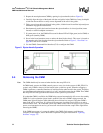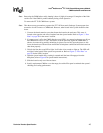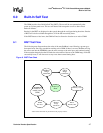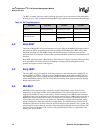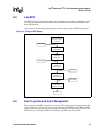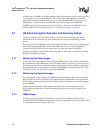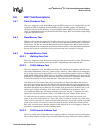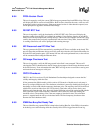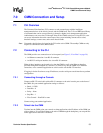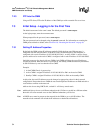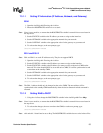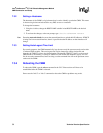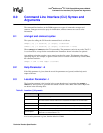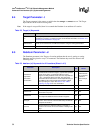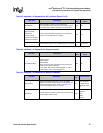
Intel
®
NetStructure
TM
ZT 7102 Chassis Management Module
Built-In Self Test
52 Technical Product Specification
6.8.4 FPGA Version Check
This test is targeted to verify the correct FPGA image programmed into both FPGA chips. This test
will display the FPGA version on both FPGAs. Both versions should be the same, or the user will
be prompted with a warning message. If the programmed version is older than the expected, user
will be prompted to upgrade to the latest FPGA image.
6.8.5 DS1307 RTC Test
This test is targeted to verify the functionality of DS1307 RTC chip. This test will display the
date/time settings from the RTC and validate the readings. If any readings found to be non-BCD
format, user will be prompted with warning message. This test will also capture current time, sleep
a while, then compare the previously captured time and new time. If they differ, it means the RTC
is working. Otherwise, user will be prompted with warning message.
6.8.6 NIC Presence/Local PCI Bus Test
This test generates the PCI bus transaction by scanning the PCI buses available on the board. This
test will detect the two Ethernet devices and verify each device has the valid Vendor ID and Device
ID in the PCI configuration space. NIC internal self-test will not be performed here, as the self-test
will be executed when loading the Ethernet driver.
6.8.7 OS Image Checksum Test
This test is targeted to verify the OS image stored in the flash is not corrupted. This test will
calculate the CRC32 checksum from the OS image, then compare with the image checksum stored
in the FIS directory. If one mismatches the other, BIST will log an error event to the event-log area
and route the error message to serial port.
6.8.8 CRC32 Checksum
CRC32 is the 32-bit version of Cyclic Redundant Check technique designed to ensure the bits’
validity and integrity within the data.
It first generates the diffusion table, which consists of 256 entries of double-word; each entry is
known as a unique diffusion code. The checksum calculation is started by fetching the first byte in
data buffer, exclusive-OR with the temporary checksum value. The resulting value will be AND-ed
with 0xFF to restrict an index from 0 to 255 (decimal). That index will be used to fetch a new
diffusion code from the table. Next, the newly fetched diffusion code will be exclusive-OR with the
most significant 24 bits of the temporary checksum value (effectively 8 bits left-shifting the
checksum value). The resulting value is the new temporary checksum value. The calculation
process is repeated until the last byte in the data buffer. The final temporary checksum value
becomes the final checksum value.
6.8.9 IPMB Bus Busy/Not Ready Test
This test identifies any potential FPGA lockup before loading BlueCat. If the FPGA is detected to
be locked up, an event indicating which bus actually failed will be logged into the Event log.



